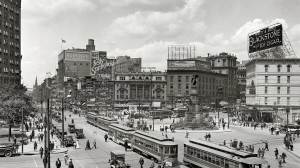
An editor with a national monthly magazine contacted me recently. He had read my Bloomberg View op-ed on shrinking Detroit, and had a proposal for an article. “Let’s say it is stipulated that Detroit has downsized, the economy is booming, and the tech world has moved in with a vengeance,” he wrote. “How should the city reimagine itself and how would it look and feel in 25 years. Who would live and work there? Are postwar Dresden, Warsaw, Pittsburgh, Montreal, or London valid precedents? Anything to be learned from the way the modern Rome is layered over the ancient Rome? Is post-Katrina New Orleans a model?”
It can be stipulated that Detroit will become a high-tech hotbed, but I can’t believe it. The work force just isn’t there. Henry Ford’s great invention was the assembly line, which allowed him to produce inexpensive automobiles. Unfortunately, simple, repetitive tasks also had the effect of reducing work skills. Very different from what was required to build a Boeing airplane for example, which is why Seattle attracted such industries as Cray and Microsoft, which did fuel a tech boom. But why would tech companies relocate to Detroit? It’s not very attractive, it’s cold, and it’s bankrupt.
Bombed cities like London, Berlin, even Warsaw, don’t offer useful lessons since their physical damage was sudden and had nothing to do with their urban viability. So they bounced back. As did Chicago after its Great Fire. You can’t keep a good city down. In any case, many of the European cities damaged in the war were national capitals–they were going to be rebuilt no matter what. The Montreal economy took a hit in the 1980s thanks to the excesses of Quebecois separatism, and if it has partially recovered (it has been far outstripped by Toronto as the prime Canadian city), that is because it is the metropole of a French-speaking province, and like Paris it is buoyed by its cultural hegemony. Pittsburgh has succeeded in remaking itself because of strong civic leadership. I don’t see that in Detroit. Also, Pittsburgh is a much smaller city, whose problems are more manageable. A large city like Detroit is another matter altogether. Scale counts.
As for post-Katrina New Orleans, the struggle that the Crescent City has had to recover after the hurricane has most to do with the poor situation before the hurricane. New Orleans has been declining for years; during the economic boom of the 1990s, metropolitan New Orleans was the only metro area in the US to actually lose population.
Much of the damage to Detroit is the result of how the city was unable to react to the changing economy after 1950. Some of this had to do with its deplorable administrations, especially that of Coleman Young, which lasted two decades. As James Q. Wilson wrote, “Mayor Coleman Young rejected the integrationist goal in favor of a flamboyant, black-power style that won him loyal followers, but he left the city a fiscal and social wreck.” Much of Detroit’s problems rests on its troubled racially-charged history.
I am convinced that downsizing is a prerequisite for a city like Detroit, but it will not solve the problem of economic stagnation, the lack of a skilled work-force, and decaying urban infrastructure. “Blow it up and start over” as Boston Mayor Thomas Menino recently suggested? Much too drastic. Tottering on is the most likely scenario. (PS I didn’t write the article.)

The top-down planning you emphasis in City Life also isn’t there for Detroit. They have the wonderful City Future Plan, but no form based code, and projects like Campus Martius and the Dequindre Cut, but no plans for playing off these improvements. Detroit won’t come back because it won’t be a beautiful place with thriving neighborhoods. There’s too much focus on social and economic issues and not enough simply on the form the city will take on this resurgence.
At PPR we are closely watching Detroit (which, as you and many others note, has shown some tentative signs of life), and also thinking about precedents — NYC in the 70s? Atlanta after the Civil War? New Orleans after Katrina? I just finished Geoffrey Kabaservice “The Village,” a history of Greenwich Village, and the overriding theme was that the Village was the Village because it was out of the way, run down, and most of all, cheap. One can’t help but think that Detroit has nearly reached that point — and never mind all the super cool post-industrial loft space, all essentially free. I’ll make a small wager: Detroit will be synonymous with “cool” in the next decade. Remember that great Eminem commercial, “Imported from Detroit?”
Cities sometimes go into permanent decline. Detroit’s past fame was built on a fleeting period when relatively unskilled mass labor built cars in huge quantities, untroubled by global competition. No thought was given to saving money for future hard times. They were not expected. Detroit never successfully upgraded the education of its work force and it is now too late to recapture past glories. It may achieve a good future, but perhaps never a great one.